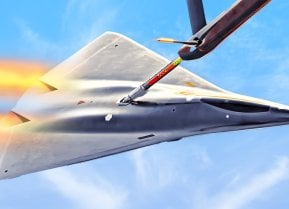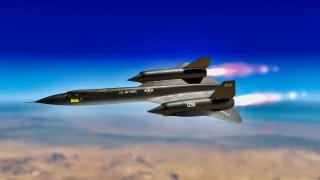Even 4,000 Miles Could Not Take Down the SR-71 Blackbird
The SR-71 Blackbird, renowned for its incredible speed and advanced reconnaissance capabilities, played a crucial role in Cold War intelligence gathering. Its ability to outrun surface-to-air missiles (SAMs) at Mach 3 speeds, coupled with its high-altitude flight and electronic countermeasures, made it nearly impossible to shoot down.
Summary and Key Points: The SR-71 Blackbird, renowned for its incredible speed and advanced reconnaissance capabilities, played a crucial role in Cold War intelligence gathering. Its ability to outrun surface-to-air missiles (SAMs) at Mach 3 speeds, coupled with its high-altitude flight and electronic countermeasures, made it nearly impossible to shoot down.
-Despite being targeted by over 4,000 enemy missiles, no SR-71 was ever lost to hostile fire.
-One of the closest calls occurred during the Vietnam War when the SR-71 narrowly escaped two North Vietnamese SAMs thanks to its speed and the quick actions of its crew. The aircraft's speed was not only a defense mechanism but also a key factor in its mission success, allowing it to collect vital intelligence without being intercepted. The SR-71 remains a testament to the power of speed in military aviation.
SR-71 Blackbird: The Spy Plane That Outran Over 4,000 Missiles
Speed can do many things for an aircraft.
It can allow an airplane to get to its target quickly and complete its bombing run.
Speed can help outmaneuver enemy fighters and shoot them down.
It enables survivability to outfox air defense systems. Spy planes such as the SR-71 Blackbird could really boogey. The Blackbird had MACH 3 speed that allowed the bird to outrun surface-to-air missiles. That’s 36.55 miles per minute or 3,216.4 feet per second.
In fact, when the SR-71 streaked by, SAMs could barely lock on to target, and if they did the Blackbird was already out of range. This allowed it to outrun and evade over 4,000 enemy missiles that were fired at it over the years.
Sometimes Enemy Radar Worked; Sometimes It Didn’t
Another thing that helped the SR-71 was its reduced radar cross section. The airplane also featured an early type of radar-absorbent iron-ferrite paint. This helped, but the airplane was hardly completely stealthy as its engines put out a large heat exhaust plume. A radar could lock onto this. It was a cat and mouse game as the SR-71 could also deploy its electronic countermeasures to jam SAM systems. The high altitude flight also helped; we are talking 85,000 feet after all. No SR-71 was ever shot down.
The Swedes Came Close
In fact, the only airplane that got close enough to an SR-71 was not a Soviet fighter but a Swedish SAAB J37 Viggen that attained missile lock and a visual on the American spy plane in 1986. On another occasion, Viggen pilots even took handheld photos of the Blackbird when an SR-71 lost an engine in 1987, and the Swedish pilots guided it to safety.
The North Vietnamese Came Closer
There was one harrowing occurrence when the SR-71 almost got shot down during the Vietnam War. Aviation Geek Club’s Dario Leone uncovered the fascinating anecdote. Reconnaissance Systems Officer Jerry Crew spoke to Air and Space Magazine, in 2014, about the first time the SR-71 was shot at by an anti-aircraft missile.
In 1968, Crew was preparing for a Blackbird mission from Okinawa that would collect intelligence over North Vietnam to snoop around Hanoi and Haiphong. The flight quickly became dangerous when the airplane hit North Vietnamese air space.
Oh No, the Worst Lights Turned On
Crew recounted, “Turning inbound on our first sensor run, I noticed the “R” light on my electronic countermeasures (ECM) panel was illuminated. A North Vietnamese SAM site was tracking us on its radar.
What we didn’t expect was the illumination of the “M” light, followed closely by the “L” light! This meant that the North Vietnamese had actually fired one or more SAMs at us. (The “R” light meant they were searching for you, the “M” light meant they were tracking you, and the “L” light meant they were launching at you,)” Crew said.

Countdown to Destruction
The incoming missile was already in the air for about five seconds. Flight time of many enemy SAMs was around 58 seconds. The SR-71 had less than a minute before impact and since it was too late for defensive maneuvers, speed would have to win the battle. The ECM jammer was not going to be completely effective. The missile was homing in on that frequency. Crew struggled to turn the ECM off. Precious seconds elapsed while he accomplished that task. The pilot kept asking, “how much time do I have?” Crew watched the clock and reported back every ten seconds. Finally, the SR-71 did its job and outran the enemy bogeys. Later, the flight camera recording showed there were actually two incoming SAMs that could have shot down the Blackbird, so this was a close call.
The SR-71 was just a blessed airplane. Pilots and RSOs were highly skilled. The maintenance crews worked hard to ensure safety. And intelligence gathered by the recon flights saved countless lives and was a factor in giving the United States the edge during the Cold War. The Blackbird’s speed won.
Expert Biography
Dr. Brent M. Eastwood is the author of Humans, Machines, and Data: Future Trends in Warfare. He is an Emerging Threats expert and former U.S. Army Infantry officer. You can follow him on Twitter @BMEastwood. He holds a Ph.D. in Political Science and Foreign Policy/ International Relations.
All images are Creative Commons.


